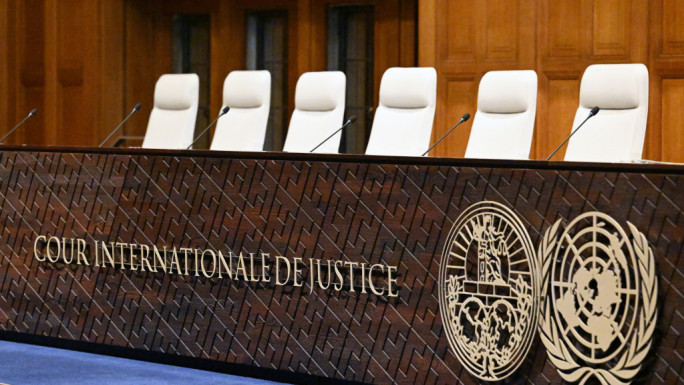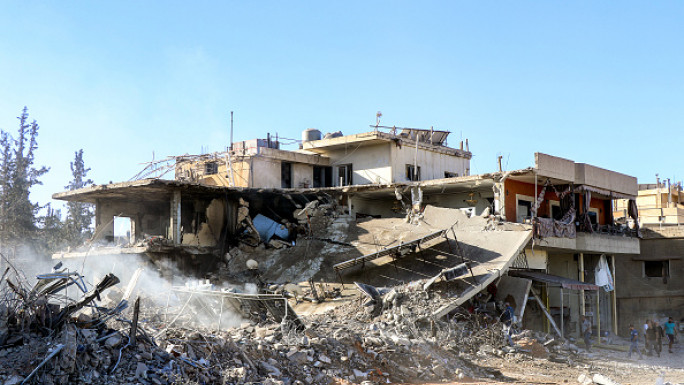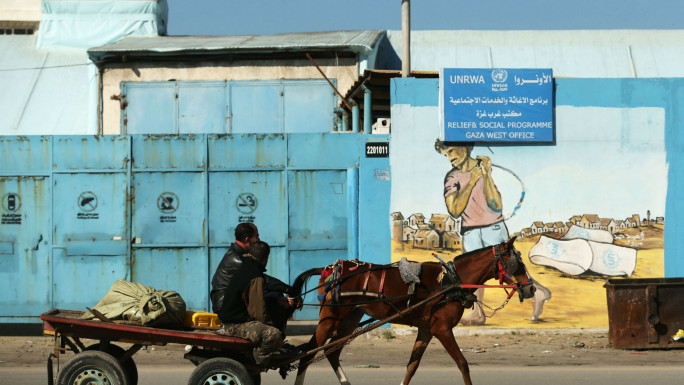
Abu Dhabi: A tale of two emirates
It is going to the Louvre in Abu Dhabi, after the emirate's Department of Culture and Tourism confirmed that it had purchased the most expensive painting in the world, using the little known Saudi Prince Bader bin Abdullah bin Mohammed bin Farhan al-Saud as an intermediary.
Why is there a sudden obsession with western art in the UAE? What has happened to generate such interest and why are the ruling family so relaxed about spending such huge sums of money on works of art, in which up until recently, they seemingly had little interest?
In the last few years, soft power strategies and image management have become ever more important to the Emirati regime as it seeks to gain global legitimacy and ensure its security in an increasingly turbulent region.
By making strategic investments in western cultural institutions, the UAE is able to project an image to the world of tolerance, openness and stability, beckoning foreign investment in the post oil diversification drive and securing key western allies in the process.
However, in the past this strategy has generally taken place externally through state aid and generous donations to fund projects such as university buildings, children's hospitals, and disaster reconstruction projects.
Yet today, we increasingly see combinations of both hard and soft power taking place in the UAE itself, specifically within the oil-rich emirate of Abu Dhabi, as it seeks to compete internally with Dubai to gain "global city" status, and more pressingly with Doha to become the region's foremost cultural centre.
This process is no more evident than in Abu Dhabi's Saadiyat Island (translated as "Island of Happiness"). A $27bn cultural hub, which already boasts both a campus of New York University (NYUAD) and the recently opened Louvre, it will also soon become host to the Guggenheim Abu Dhabi Museum designed by Frank Ghery, as well as the Zayed National museum, to which the British museum is a key partner.
 |
It is the Louvre Abu Dhabi itself that constitutes a key pillar of deception within the country |  |
These developments did not pass without controversy, both for the institutions associated with them and the Abu Dhabi government itself.
Similar to the criticism Qatar has faced over its hosting of the World Cup, an unwelcome light has been cast on the plight of the country's migrant worker population in the emirate, with international media outlets and rights organisations exposing the appalling conditions those labouring on the projects have endured throughout the construction process.
Nevertheless, being linked to such iconic western institutions brings a certain prestige for an authoritarian regime looking to gain regional hegemony and legitimise itself on the world stage.
The growing cultural metropolis of Saadiyat Island creates a sort of mirage which enables the UAE to present itself as an oasis of calm and stability in a volatile region. Moreover, by attracting world dignitaries and leaders to the Island, the Emirati regime justifies itself on the global stage and draws attention away from its increasingly poor human rights record.
At the unveiling of the Louvre Abu Dhabi a few weeks ago, Emmanuel Macron hailed the 10-year project as a stand against the "lies" of "obscurantism". However, one does not need to dig very deep into the Emirati regime's recent record on human rights to discover that in fact it is the Louvre Abu Dhabi itself that constitutes a key pillar of deception within the country.
In clear juxtaposition, situated barely 100km from the Louvre's dazzling architectural grandeur is al-Razeen prison.
The prison, which lies in the blistering heat of the desert just outside Abu Dhabi, has been dubbed the "Guantanamo of the UAE" by human rights campaigners.
 |
The growing cultural metropolis of Saadiyat Island creates a sort of mirage which enables the UAE to present itself as an oasis of calm and stability in a volatile region |  |
Arguably it is another western inspired import, though in this case, it is used inconspicuously by the regime for the purposes of hard power. Home to scores of political prisoners including academics, bloggers, human rights lawyers, and judges who dared to speak out against the regime, al-Razeen prison has become notorious in recent years for the degrading and abusive conditions to which the inmates are subjected.
Earlier this year, Emirati "prisoner of conscience" Imran Radawan endured almost two months on hunger strike in protest against the conditions at the prison after he was beaten and sexually assaulted by warders.
Twitter Post
|
The facility has been used extensively since the infamous "UAE 94" show trials in 2013, which led to the imprisonment of 69 social and political activists who campaigned for democratic reforms in the country by submitting a petition to the ruling authorities.
One of those imprisoned is the internationally respected human rights lawyer Mohammed al-Roken, who is currently serving a 10 year sentence. Earlier this year he was awarded the prestigious Ludovic Trarieux Award by the European Bar Association for "devoting two decades to defending fundamental freedoms".
In 2015, Amnesty International reported that that al-Roken was suffering from high blood pressure and panic attacks after prison authorities installed loudspeakers in his cell and played propaganda music at excruciating volumes for hours on end. These methods of torture are darkly reminiscent of those implemented by US interrogators at Guantanamo Bay.
The prison is seemingly a million miles away from the iconic international institutions to which Abu Dhabi has become host in recent years. Yet up until recently it held Nasser Bin Gaith, a distinguished Emirati economist and lecturer at the Abu Dhabi branch of the Sorbonne University. In March of this year he was sentenced to 10 years in prison for tweeting about human rights abuses and the politicisation of the Emirati judicial system.
Bin Ghaith's whereabouts is currently unknown after UAE authorities transferred him from the facility in August of this year to an unknown location.
Read more: Raped in a UAE cell, victim turns to Scotland Yard
In stark contrast to the scholarly debate, creativity and values of tolerance that the Emirates supposedly eschews through institutions such as those on Saadiyat Island, al-Razeen is symptomatic of an increasingly repressive society that now has one highest rates of political prisoners per capita in the world.
Yet despite this, western governments continue to maintain close ties with a regime whose human rights record has been routinely condemned in recent years by prominent and respected human rights groups such as Amnesty International and Human Rights Watch.
It is within this context, however, that projects such as the Louvre and NYUAD benefit the Western powers themselves.
 |
|
| Abu Dhabi Crown Prince Mohammed bin Zayed Al-Nahyan greets French President Emmanuel Macron and his wife Brigitte Macron at the entrance of the Louvre Abu Dhabi Museum on November 8, 2017 [AFP] |
They provide a glossy veneer to a relationship with a state that, in reality, has far more to do with strategic military interests, weapons contracts and the steady flow of oil than cultural collaboration. Moreover, ensuring the stability of a pliant Emirati regime in the Arabian Peninsula is absolutely central to their wider strategic and economic interests in region.
After unveiling the Louvre to the world, Emmanual Macron toured the French naval base at Abu Dhabi's port Zayed which was opened by his predecessor President Sarkozy in 2009, just two years after the Louvre partnership was announced. Macron wrapped up his visit by announcing the sale of two military warships to the Emirati regime.
Similarly, not far from NYUAD in Abu Dhabi is the air base of al-Dhafra, that is home to around 3,500 US military personnel. The base has been crucial to American military ambitions in the wider region.
With the UAE actively participating in every US invasion since the first Gulf War in 1991 bar Iraq in 2003, it has become an increasingly reliable ally in the region - so much so that US military generals have nicknamed the UAE as their "Little Sparta" for their military prowess.
 |
In the last few years, soft power strategies and image management have become ever more important to the Emirati regime |  |
Reflecting the increasingly interventionist role the UAE has taken in the region since the Arab Spring of 2011, its military expenditure has shot up. According to estimates made by the Stockholm International Peace Research Institute (SIPRI), it increased by 63 percent between the periods 2007-2011 and 2012-2016, with the US and France acting as major suppliers.
Despite declining prices in oil and persistent structural imbalances in the Emirati economy, in 2014 alone, it spent $22.8bn on defence capability. The enormity of this kind of military spending has led some, such as Gulf specialist Christopher Davidson, to conclude that arms imports are better understood as a sort of protection racket issued by western powers in exchange for regime security.
Earlier this month, the UAE armed forces took part in joint military exercises with UK, US, and French armies in Abu Dhabi. These joint exercises, codenamed "flag 4", would - according to the UAE state-owned paper The National - "consolidate multilateral relations and increase coordination between the UAE armed forces and its counterparts".
It is developments such as these that constitute the flip side to both western and Emirati soft-power initiatives outlined above. In some respects, NYUAD, Guggenheim and the Louvre provide effective PR cover to suit the narrow interests of the Emirati regime and western arms companies and governments.
However, as human rights abuses in the UAE increase, it is imperative that people in the West see these projects for what they are, and put substantial pressure on their respective governments to cut ties with the UAE until they adhere to international human rights legislation.
Until this happens, one can only remain cynical about the prospects for freedom, democracy and human rights to prevail in the country.
Joe Odell is Press Officer at the International Campaign for Freedom in the UAE. He has an MA in Middle Eastern Politics and regularly writes and speaks on the Middle East, especially the Gulf region.
Follow him on Twitter: @JoeOdell3
Opinions expressed in this article remain those of the author and do not necessarily represent those of The New Arab, al-Araby al-Jadeed, its editorial board or staff.





 Follow the Middle East's top stories in English at The New Arab on Google News
Follow the Middle East's top stories in English at The New Arab on Google News


